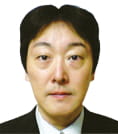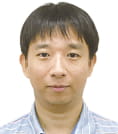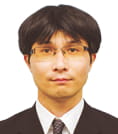- JST Home
- /
- Strategic Basic Research Programs
- /
 PRESTO
PRESTO- /
- project/
- Large-scale genome synthesis and cell programming/
- [Genome programming] Year Started : 2018
[Genome programming] Year Started : 2018
Hiro-oki Iwakawa
Evading unwanted RNA silencing: Toward large-scale genome reconstitution
Researcher
Hiro-oki Iwakawa

Lecturer
Institute for Quantitative Biosciences
The University of Tokyo
Outline
RNA silencing frequently interferes with the expression of transgenes in plants. This is a big problem for future breeding technologies including large-scale genome reconstruction, which will eventually enable the mass production of useful materials. In this project, I aim at revealing hidden rules that govern RNA silencing by the combination of newly established in vitro systems and bioinformatics approaches. These rules will be exploited to develop novel techniques that allow the efficient expression of transgenes by suppressing undesirable RNA silencing.
Junichiro Ohzeki
Design, construction and generalization of human artificial chromosome using a mega-base sized synthetic DNA
Researcher
Junichiro Ohzeki

Researcher
Department of Frontier Research and Development
Kazusa DNA Research Institute
Outline
Human artificial chromosome (HAC) is a chromosomal vector that can load megabase-scaled (million base pairs) DNA; it is a promising vector for producing useful materials and/or regulating cellular functions in higher eukaryotes. In this research, using methods of synthetic biology, I will clarify the operating principles of the HAC as a model of natural human chromosomes, and establish fundamental materials and procedures for loading genome-scaled synthetic DNA onto the HAC and utilizing this DNA fusion system by developing a technology for joining artificially synthesized DNA fragments to produce DNA on a megabase scale.
Daisuke Kurihara
Development of long-chain DNA introduction techniques for plants by membrane fusion
Researcher
Daisuke Kurihara

PRESTO Researcher
Japan Science and Technology Agency
Outline
To achieve the introduction of long-chain DNA into plant cells, I aim to develop techniques for introducing DNA into the zygote or the embryo and making long-chain DNA-integrated plants without somaclonal variation. These techniques could be a breakthrough to quickly create valuable plants.
Yutetsu Kuruma
Construction of Artificial Cells Composed of a Minimal Genome
Researcher
Yutetsu Kuruma

Researcher
Institute for Extra-Cutting-Edge Science and Technology Avant-Garde Research
Japan Agency for Marine-Earth Science and Technology
Outline
This project aims to construct an artificial cell that consists of a minimal genome satisfying the essential metabolic conditions for self-reproduction and a reconstructed transcription-and-translation system. The designed artificial cell will be formed within a micrometer-sized lipid vesicle compartment, in which the encapsulated genome expresses its function through protein synthesis. Specifically, I am focusing on functional cell membrane components such as transporters that import energy or substrates from the environment, or lipid-synthesis machinery for enabling and controlling the growth and division of the artificial cell. This synthetic biological technology will be a beneficial tool in genome programing research for detailed analysis of the functional expression of designed genomes in defined cell systems.
Shu Kondo
Synthesis of megabase DNA by chromosome engineering in Drosophila
Researcher
Shu Kondo

Assocate Professor
Faculty of Advanced Engineering
Tokyo University of Science
Outline
Despite recent advances in DNA synthesis technologies, synthesis of animal chromosomes, which often exceed 100 Mb, remains a major challenge. The project aims to exploit the powerful genetic tools of the fruit fly Drosophila to develop a new method for constructing megabase DNA by assembling hundreds of DNA parts in vivo. I will use site-specific recombinases to iteratively induce unequal crossovers between transgenes integrated at the same locus. Compared to existing methods, the proposed system exponentially accelerates the assembly process and will eventually allow the construction of 100-Mb DNA in one year.
Yasukazu Daigaku
Elucidating the DNA structure of replicators and controlling chromosome replication
Researcher
Yasukazu Daigaku

Assistant professor
Frontier Research Institute for Interdisciplinary Sciences
Tohoku University
Outline
To stably maintain artificial chromosomes or genetic carriers in living cells, these molecules need to be replicated autonomously. This research aims to unveil sequences and structures of replication-initiation sites (replicators) and their activity in the human genome, finally establishing the basis for designing replicators and enabling the control of DNA replication in human cell cultures. To this end, I will develop an experimental system to investigate the genome-wide movements of replication forks by examining the usage of replicative DNA polymerases, and then reveal the positions and activities of replicators globally.
Tomomi Tsubouchi
Manipulating cell identity through cell fusion and separation
Researcher
Tomomi Tsubouchi

Assocate Professor
National Institute for Basic Biology
National Institutes of Natural Sciences
Outline
This research aims at constructing a system that allows efficient cell fusion and separation, which will be established as a method for introducing/eliminating long chromosome-scale DNA fragments. Such a system not only allows us to “add” long DNA fragments into cells but also allows to “transiently expose” cells to factors expressed from the DNA without altering genomic information. This feature is particularly useful for manipulating the cell identity by transiently exposing cells to an elaborate network of epigenetic regulators.
Nozawa Kayo
Molecular mechanism of transcriptional initiation regulated by Mediator and higher-order chromatin architectures
Researcher
Nozawa Kayo

Research Assistant Professor
Institute for Quantitative Biosciences
The University of Tokyo
Outline
Cell type-dependent gene activation is enabled by the three-dimensional regulation of chromatin conformations, which involves DNA looping. Mediator is a key multiprotein complex that directly connects the enhancer DNA element to the RNA polymerase II (Pol II)-bound promoter region to form a DNA loop. Mediator and the other general transcription factors provide a platform for transcription initiation by Pol II, thereby transcribing different classes of genes. This project aims to elucidate the atomic structure of holo-mediator using X-ray crystallography and cryo-EM, to reveal the molecular mechanism of transcriptional initiation and epigenetic regulation thereof. In addition, to investigate how Mediator affects multi-step transcription through DNA looping, structure-based analysis of enhancer proximal regions, including those in activators and epigenetic marks on nucleosomes will be carried out.
Tetsuya Yamamoto
Physics of gene regulation due to the clustering of DNA
Researcher
Tetsuya Yamamoto

Specially Appointed Associate Professor
The Institute for Chemical Reaction Design and Discovery
Hokkaido University
Outline
The clustering of DNA is analogous to the micellization of telechelic associative polymers. In this project, we take into account the fact that cohesin actively changes the conformation of DNA, and that it diffuses along the DNA to dissociate the binding between superenhancers, in an extension of the theory of the micellization of telechelic polymers to theoretically predict the size of DNA clusters and the transcription rate of genes in the clusters. The aim of this project is to understand the physical mechanism of transcriptional regulation due to superenhancers by using the theoretical approach.













